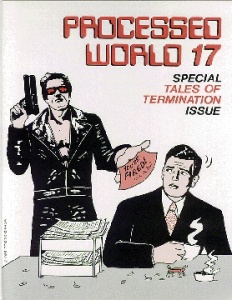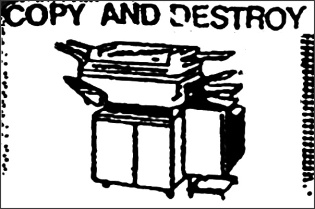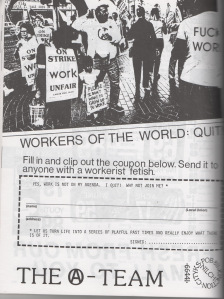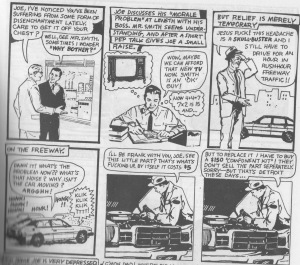At a crucial turn in William Gibson’s Neuromancer, we’re introduced the Panther Moderns – a guerrilla subculture in a world where subcultures flicker by like disconnected frames of some montage film. The Panther Moderns specialize in hallucinatory simulations – in a world dipping into the “consensual hallucination” of cyberspace, they build hallucinations on top of it, subverting a reality that is already subjected to constant reconfiguration through digitalization, genetic body modification, and psychotropic drugs. If cyberpunk, as Lewis Call insists, picks up where Baudrillard’s delirious hysteria over the becoming-simulation, becoming-simulacrum of reality leaves off, figures like the Panther Moderns show the escape route. They embody the old ‘Mao-Dadaist’ slogan of the Autonomists rallied around Radio Alice: “false information produces real events.”
The political ramifications of the Panther Moderns, beyond the literary depiction of our very real world, did not go unnoticed. A group of theory-heads involved with ACT UP, a direct action/political advocacy group dedicated to revising awareness over the AIDs epidemic, read Neuromancer and took inspiration from the Panther Moderns. They christened themselves the Critical Art Ensemble, and began making waves with their elucidation of “tactical media” and their provocative stance that “as far as power is concerned, the streets are dead capital!”[i] Better to contest power right in the heart of its new ambiguity – the electronic flows that replace former sedentary masses. By being plugged into strange and wonderful history of tactical media, William Gibson finds himself embedded in a rhizomatic sprawl running back to the Dadaist and earlier and up to Occupy Wall Street and beyond – with a whole host of avant-gardes, freak scenes, reality hackers, and anonymous revolutionaries kicking around in between.
The Panther Moderns, in Gibson’s world, are something of an avant-garde. With an array of practices and/or tactics hanging hazily between political action, artistic expression, and general trouble-making, their nihilistic surroundings finds their real world compliments in the industrialized Paris that so inspired the Decadents and the later Surrealists, the Saint-Germain scene that spewed out not only existentialism but the Situationists, or the avant-political networks that gave the world urban guerrilla commandos as much as it did Krautrock. What is it about the thin lines that exist between art, radical politics, and criminality? What makes these birds, seemingly of different species, flock together? And what do we make of the general atmosphere of radical urban transformation, encroaching poverty, and industrial ruination that spark them?
For now, I’d like to leave that up for others to untangle, and turn now to Accelerationism, that term so debate, celebrated, and reviled in equal terms. By two, some two years after Srnicek and Williams simultaneously equated accelerationism with left-wing technological development and dragged Nick Land and the CCRU out of the shadows that they hoped to resign them to, nearly every militant political moment has been brought together under the ‘Accelerationist’ label – almost to the point where the term hardly holds any meaning whatsoever. Marx encouraged technology’s ability to open up free time? Accelerationist. The Soviets looked towards computer automation to eliminate the traces of capitalist labor relations? Accelerationist. The Situationists wanted to turn cybernetics over to worker’s councils? Accelerationist. The ambiguities of communization theory? Accelerationist. Deleuze and Guattari, Lyotard, Baudrillard, Hardt, Negri – Accelerationism all the way down.
So ultimately, it’s not my goal to go indulge the adding of another name to the ever-expanding roster. That said, that’s precisely what I’m going to do – albeit with a little different spin.
Over at the blog Obsolete Capitalism we find some rather unacknowledged information about the now-famous quote from Deleuze and Guattari’s Anti-Oedipus, where they ask if Nietzsche was right all along and the decoding of flows (the capitalist processes of deterritorialization) needs to be accelerated – rather than the retreat into left-wing nationalism. Much has been made about the rejection of an important left-wing strategy deployed against multinational capitalism, and the way that accelerating capitalism’s expansion appears, at first glance, to be an odd veer into some sort of post-Marxist libertarianism (to deploy the term in contemporary parlance). Much less has been made about Nietzsche’s role in all of it – namely, where exactly did he say we had to accelerate decoding, and what did he mean by this? Obsolete Capitalism points us towards a fragment of Nietzsche’s titled “The Strong of the Future”, which was commented on at length in Pierre Klossowski’s Nietzsche and His Vicious Circle – a text that would come to bear an incredible influence over Deleuze, Guattari, Foucault and the other post-structuralist theorists. In fact, as Obsolete Capitalism points out, it was Klossowski’s decision to translate the term deployed by Nietzsche as “accelerate”, thus giving rise directly to Deleuze and Guattari’s interpretation.
For Nietzsche, the levelling of society through modernizing forces will produce, as a sort of strange side effect or mutation that will affirm the dissolution of their traditionalist bonds and boundaries while carrying out an overcoming of the system that put them into play. Accelerationism, in the Nietzschean perspective, is less about pushing laissez-faire economics into apocalyptic overdrive or the unshackling of technology’s restraints. It’s about the fomenting of contrarian subjectivities – and in this sense it’s very much an affair of avant-gardes. The mad modernists wandering in the ruins, the leftist psychedelia of Vaneigem, the all-night jazz parties in Saint-Germain, the Autonomists celebrating the artificiality of simulation.
Hardt and Negri, who deploy the quote from Anti-Oedipus for their own ends (to invoke the multitude pushing Empire through to its other side, in a clear anticipation of Srnicek and Williams), also turn to Nietzsche as a figure to be hold clues to the future. Citing from The Will to Power (in which “The Strong of the Future” appears), they seize upon the figure of the barbarian, who will “come into view and consolidate themselves only after tremendous socialist crises.”[ii] Hardt and Negri stress that the barbarian “while escaping from the local and particular constraints of their human condition, must also continually attempt to construct a new body and new life.” In a footnote to this section of Empire they tell us that in cyberpunk fiction the barbarian find clues to its future beyond the rubble. A Panther Modern lurks in that direction.
Enter Semiotext(e), purveyors of what I would like to dub “grungy accelerationism”. It’s a dumb name, for sure, but I would like to clarify exactly what it means. Accelerationism here is used in the sense sketched about, as a sort of mutant subjectivity that begins (and ends) amidst the rubble of capitalism’s deterritorializing modernization processes. This also gives us a temporal space, marking the period prior to the inevitability of capitalism’s reterritorializing tendencies, which sorts through exactly what it’s made unhinged and puts it back together. Grungy, on the other hand, is a word that conjures up images of the 1990s – flannel shirts, bummed out kids, and the generalized ‘slacker attitude’ that prevailed in the underside of the Clinton economy. What’s more important, however, is what lurks behind these corporatized images: a sort of street nihilism where the punk mantra of “no future” becomes a way of life, and the conditions for new coordinates of living and do-it-yourself attitude fester and take root – all the while acknowledging the essential bullshit of the spectacle. And a caveat: this is not an attempt at periodization, or theory, or an excuse to canonize anything in orthodoxy. More than all, this is an excuse to point out a few – and maybe ultimately unimportant – aspects out there on the margins.
The origin of Semiotext(e) dates back to the early-to-mid 1970s, when Sylvere Lotringer – French immigrant and close friend to the celebrities of post-structuralism – got together with some of his students at Columbia University, where he taught courses on semiotics, to release a kind of underground ‘zine that would bridge the gap between French theory and the “downtown” arts culture that had weaved its way through New York City since the 1950s. Downtown culture was large and heterogeneous: it founds its origins in circles around the abstract expressionists (Jackson Pollock, Theodore Roszak, William de Koonig, etc) and the Fluxus artists (John Cage, Yoko Ono, George Maciunas, etc); it continued down through the minimalists (La Monte Young, Terry Riley, Philip Glass, etc) and Andy Warhol’s Exploding Plastic Inevitable and the Velvet Underground. It explored through punk rock (Richard Hell and the Voidoids, Television, the Ramones, etc) and later gave rise to no wave (Mars, DNA, Teenage Jesus and the Jerks, etc). It counted in its ranks innumerable poets, artists, painters, performance artists – and even more innumerable unclassifiable individuals who eschewed arts for a life near the bottom. It habituated in clubs and secreted away spaces like the Kitchen, Colab and the Mud Club; it has now given rise to an entire industry of retrospection.
In the mid-1970s French theory was all but unknown – but its essential topics (subjectivity, power, rhizomes, nomadism, simulation, libidinal economics) seemed to Lotringer to speak not so much to the possibility of a revolution to come in Europe, but the actual practices being put into play in the United States. This is the usually accounted for origins of Semiotext(e); Lotringer’s own recounting of the publication’s founding hints towards what today is well known in critical circles as Accelerationism. Anti-Oedipus was the lynchpin, assimilating the demands of the desiring-revolution in May of 1968 with a new interpretation of how capitalism functions. Deleuze and Guattari, Lotringer says, were “upping the ante on Marx by observing that capital, far from being a purely repressive, ruthless mechanism meant to extract surplus-value, was constantly creating new values and new possibilities. And since capitalism absorbed everything, the trick was to counter it from within, redirecting its flows, ceaselessly moving ground.”[iii] Since France was dominated by heavy bureaucracy directed by cybernetically-minded socialists-turned-marketeers, this position was simply “science fiction”, while in America – and New York City in particular – it was immediately recognizable.
In the issue of Semiotext(e) dedicated solely to Anti-Oedipus, published in 1977, these ideas are grounded even more firmly. In an essay section titled “Project for a Revolution in New York”, Lotringer writes that “The gamble of Anti-Oedipus is to reformulate revolutionary perspectives from the strong points, and the weak links, of capitalism.”[iv] Another essay in the issue, written by Lyotard with the name “Enurgumen Capitalism”, defines the revolutionary subject of Anti-Oedipus as the artist who struggles “to make himself inhuman”, and points towards its relationship with the flows of the libidinal economy that forever surpass their limits. In 2014 “Enurgumen Capitalism” would find its reprint – this time in the #Accelerationist Reader. “Nietzsche’s Return,” a Semiotext(e) issue from the same year, contains Deleuze’s essay “Nomad Thought”, where he quotes “The Strong of the Future” and adds “Faced with the decoding of our societies, the leaking away of our codes, Nietzsche is the one who does not endeavor to recode. He says: things still haven’t gone far enough, you are just children yet… In his writing as well as his thinking, Nietzsche pursues an attempt at decoding: not in the sense of a relative decoding which would consist in deciphering antiquated, current or future codes, but in the sense of an absolute decoding- the introduction of something that isn’t encodable, the jamming of all codes.”[v] A handful of pages later we find Lyotard again, this time celebrating Nietzsche’s projected decomposition of coordinates, and aligning this celebration on one hand with capitalism’s tendency towards dissolution, and the music of John Cage on the other.
Across the 1970s, capital burned through a great many areas of New York City and left in its wake a hulking shell of what had once been a metropolis. Decades earlier Robert Moses, the so-called “Master Builder”, had went to work re-organizing the city’s urban space – crisscrossing it with highway and unmaking its neighborhoods in a grand vision of scale on par with Hausmann’s reconstruction of Paris under the watchful eye of Napoleon. But the city of the future would not be realized: the neighborhoods transformed by Moses’ top-down planning never recovered, and thanks to newly laid expressway systems were cut from the organic urban fabric. Compounded with corruption and mismanagement of public funds, the city teetering on the edge of bankruptcy by 1975. By this point, vast areas of the Lower East Side were empty, the streets lined with vacant lots and stores. Lydia Lunch recounted that “There were just blocks and blocks of abandoned buildings, set on fire nightly from people sleeping under tea lights,” while the filmmaker Scott B added “You could go to a building and take it over– steal electricity out of the lamp post and live in it for years.”[vi]
In the eyes of Lotringer and Semiotext(e) this was becoming the staging ground for the emergence of “schizo-culture”, taking its cue from Deleuze and Guattari’s depiction of schizophrenia as a process of decoding and deterritorialization – not unlike capitalism but capable of making revolutionary breaks from the power it wields. In 1975 Semiotext(e) organized the Schizo-Culture conference at Columbia University, bringing together Deleuze, Guattari, Foucault and Lyotard with Cage, Burroughs and other members of this Downtown scene – but rather from being an academic success, it served to estrange Semiotext(e) from the university and push it into direct interaction with the street culture it sought to analyze. By the time the “Schizo-Culture” issue was released in 1978, the aesthetics of the magazine resembled a punk ‘zine more than anything, even if the first article is an interview with Foucault.
The notion of Schizo-Culture is precisely what I call grungy accelerationism – both move in the wake of capitalism’s flows and find their meanings to autonomy in the left-overs. A case in point was art “movement” of no wave, which grew in the abandoned districts of the Lower East Side and whose cacophony made the punk scene sound conservative. Bands like Teenage Jesus and the Jerks, Mars, DNA, James Chance and the Contortions, the Theoretical Girls and the Gynecologists took street nihilism as their launching pad, and used stake out a territory far beyond the co-opted, mass-produced culture of the 1970s. For the brief period of its existence, the no wave scene saw the collapse of boundaries between artistic disciplines – everyone was a musician, a sculptor, a painter, a writer, and a filmmaker. The hollowing-out of New York City allowed them to pursue these goals without resorting to wage labor. In a retrospective, Lydia Lunch recalled “Work? Are you nuts? Please. $75 per month– that was my rent when I got an apartment on 12th Street.” As in early avant-gardes, the line between arts and criminality blurred; many resorted to illegal means for money when it was necessary. In grungy accelerationism, life isn’t easy or pretty, but to quote Scott B “You can’t imagine the freedom that we had. The middle class had abandoned the place, and we just walked in and took it.”
Semiotext(e) made its home in the no wave scene, with many of the artists taking part in putting the publications together. Take for example Diego Cortez, the director of the Mudd Club (the central locus of no wave music) and an organizer of a concert that brought together the downtown music scene with the concept artists from Soho, took helm on designing the lay-out several issues; his impact was felt on the immediate follow-up to schizo-culture, 1979’s “Autonomia: Post-Political Politics”. The purpose of this issue was to bring together the struggles of the Italian Autonomia with no wave, the two having emerged at the same time (albeit on different continents). Like their New York counterparts, the Autonomists took a strong line against labor, calling for a refusal of work and the glorification of idleness instead. Antonio Negri, in his classic text “Capitalist Domination and Working Class Sabotage” (a fragment of which can be found in the Semiotext(e) issue), channeled punk energy by asserting “We have a method for the destruction of work. We are in search of a positive measure of non-work, a measure of our liberation from that disgusting slavery from which the bosses have always profited, and which the official socialist movement has always imposed on us like some sort of title of nobility. No, we really cannot call ourselves ‘socialists’ for we can no longer accept your disgrace.”[vii]
The Autonomia also held a certain debt to the French theorists, most specifically Deleuze, Guattari, and Baudrillard. The various tactics they deployed – pirate radio stations like Radio Alice, the refusal to work, the rejection of parliamentary politics, the usage of squats, and the bringing of the strange into everyday life (such as the case of the Metropolitan Indians, who wore face painted and prowled the streets of Rome, staging spontaneous urban) interventions such as impromptu concerts) – embodied the ideas of a schizoid revolution. Guattari would agree in full, writing in a text titled “The Proliferation of the Margins” that in the case of the Autonomia, “the lines of flight merge with the objective lines of deterritorialization.”[viii] Again, we find the theme of revolution emerging in the wake of capitalism’s flows, a molecular uprising amongst the ruins.
Guattari pondered whether or not this molecular revolution could “take charge of not only local problems, but also administrative larger economic configurations”. The inevitable reterritorialization of capitalism’s flows took place instead. In the case of Italy, the Autonomia was dismantled under the state’s enacting of emergency laws. In New York City, the administrators had enacted a series of economic reforms following the near-bankruptcy of 1975; as the Reaganite 80s loomed, finance and real estate capital swept through the city, raising property rates across the boards and expunging the artists from their lofts. Flush with money, art patrons, rich collectors, and gallery owners turned their eyes to the concept artists, painters, and sculptors. Almost overnight the spontaneous immediatism of the downtown culture transformed into the affluent art market. Semiotext(e) rode this wave, shifting away from ‘zine-style publications to their “Foreign Agents” series – pocket-seized theory fragments bearing minimalist, black covers. The goal was to carry out the Situationist gesture of creating an “explosion in the heart of the commodity”, a sort of homeopathic antidote to the commoditization of all things radical and militant. One wonders, however, to the extent that “Foreign Agents” deviated from the spectacular wave of finance capitalism: with their aesthetic sheen and mobile nature, the books doubled as a fashionable accoutrement, something to be seen while reading in the subway or to show off to friends at a party. Case in point is the release of Baudrillard’s Simulation. Instead of throwing down the gauntlet, the ideas of hyppereality and simulacrum were stripped of their postmodern anarchist, cyberpunked potentials. It became the lingua franca of the art market itself, the new territory of the commodity sprawl.
Now we turn to Autonomedia, a radically anarchist book publisher that became Semiotext(e)’s main distributor in the early 1980s. Best known for publishing works in the vein of Hakim Bey’s T.A.Z. and the militant writings of Ron Sakolsky, Autonomedia can be immediately contextualized in what is now commonly referred to as “post-left anarchism”. At the same time, I would argue that they – and the texts they print – embody what I’m referring to as grungy accelerationism. Instead of opting for a direct confrontation with the powers of capitalism, the bourgeoisie and the state (as Marxist-Leninism or communization theory might pose, in their own different routes), what was promoted instead was the construction of alternative, aesthetically experimental, DIY networks right in the midst of the ruins. John Cage, concept art and minimalist music mattered much less here than the ability to take theory out of its contexts and insert it into a gleeful, deviant intransigence.
Autonomedia’s output is a small glimpse into a wider world, of which the downtown scene of New York City had been the recognizable tip of the iceberg. This was a world populated by anarchists, drop-outs, schisms groups, kooks, cranks, professional idlers, punks, nomads, parody mystics, vagabonds, and other figures that, to quote Anti-Oedipus, “know how to leave, to scramble codes, to cause flows to circulate…”[ix] This world had its own passcodes, rituals, and objects that circulated outside of commodity of relations. ‘Zines were an essential aspect of this circulation, as were cassettes of garage bands and noise music; mail art (with its own origins in the Fluxus movement) helped tie the whole network together.
Staying true to their insistence that the underside of America culture gave form to the abstract militancy of the French theorists, Semiotext(e) released in 1987 Semiotext(e) USA, edited by Jim Fleming (the editor of Autonomedia) and Peter Lamborn Wilson (better known as Hakim Bey). A dense compilation of writing, letters, comics, advertisements, and unclassifiable, Semiotex(e) USA performs a living archeology of this underground world. Like the Autonomia and the no wavers before them, a reoccurring theme is the refusal of work. Bob Black’s famous “Abolition of Work” appears next to anarcho-syndicalist propaganda material, detourned ads from women’s magazines calling on people to leave their careers, and comics suggesting that micropolitical revolution is no different that the so-called macropolitical transformations. The point is driven home clearly in a picture of a woman looking on wistfully, a wall clock ticking behind her. “So many revolutionaries without a revolution,” the thought bubbles above her head say. “I want a revolution without revolutionaries!”
Semiotext(e) USA acts as a performative text. The last second of the book contains veritable classifieds section, full of addresses and advertisements for ‘zines, various fringe groups, ‘strange individuals’, and conspiracy nuts. A full page is dedicated to the Church of the Subgenius, a parody religion founded by Ivan Stang. Beyond the Church’s relationship to the postal avant-garde (through its connections to Neoism, cassette culture, and mail art writ large), the commonalities are clear: the Church preaches a gospel of ‘slack’ instead of work, and encourages the ‘followers’ to reach out and learn from every fringe subculture, conspiracy group, and religious sect imaginable. By providing a dialogue to these rhizomatic sources, Semiotext(e) USA invited the reader to participate directly in this world.
Two years later, Semiotext(e) and Autonomedia unveiled their follow-up to Semiotext(e) USA – the aptly named Semiotext(e) SF. The topic here is accelerationist avant-lettre genre of cyberpunk and other mutant strands of science fiction. If USA was a cartography of the existing underground, SF aimed to show exactly grungy accelerationism was going – the editors (Peter Lamborn Wilson/Hakim Bey, Robert Anton Wilson and Rudy Rucker) note that made of the contributions they culled together “emerged largely from underground world of xerox microzines and American samizdat: writers so radically marginalized they could never be co-opted, recuperated, reified or bought out by the Establishment.”[x] When it comes to the well-known names of the genre (William Gibson, Bruce Sterling, etc.) the punk in cyberpunk is emphasized. “One imagines them,” they say of the authors, “as crazed computer hackers with green mohawks and decaying leather jackets, stoned on drugs so new the FDA hasn’t heard of them yet, word-processing their necropsychedelic prose to blaring tapes by groups with names like The Crucifucks, Dead Kennedys, Butthole Surfers, Bad Brains…”
On the first page of Semiotext(e) SF we find the words “NO WAVE SF”. While this pointed isn’t elucidated, perhaps there is more going on there than an attempt to forge a bridge between the future and the past. Let’s take for our example Glenn Branca, who cut his musical teeth in the no wave band Theoretical Girls before releasing a series of extremely abstract works that blended rock guitar with the minimalist drone music of La Monte Young and Terry Riley – the culmination of an experiment launched by the Velvet Underground in 1966. Branca’s albums abound with references to Baudrillardian simulation and the Situationist critique of the Spectacle; it should not be so surprising, then, that he later could be found selling used copies of cyberpunk novels from his website. As James Reich puts it, there appears to be a distinctive – yet discrete – congruence between Branca’s liquid-metal guitar soundscapes. Describing the premier of his “Symphony No. 12” in 1997, he writes “For those of us that did not flee the auditorium covering our ears, Branca’s music possessed us (and continues to possess) with structures, planes, and hyperspaces, compelling a weird consensual hallucination in the distortion.”[xi] Rooting through the overlap between music and visual arts in New York City, he adds that “Branca the cyberpunk aficionado is… the link between artist Robert Longo whose work from the Men In The Cities series Branca used on the cover of his album The Ascension (1981) and Longo’s movie Johnny Mnemonic (1995) based on Gibson’s short story of the same name (1981)…”
An even more direct point of (sub)cultural connection comes with the Sonic Youth, the now-famous band that emerged at the tail end of no wave (with the first several of their albums produced by Branca. After a slew of releases following the no wave template – and bearing the usual no wave subject matter – they shifted gears and began peppering their music with references to the schizophrenic science fiction of Philip K. Dick and the cyberpunk of William Gibson. Their seminal Day Dream Nation, for example, boasts a track titled “The Sprawl” – the name of the dystopic super-city in Neuromancer and its sequels. The implication is that the underground New York City – the one that produced downtown culture, no wave, and the other elements in Semiotext(e)’s conception of “schizo-culture” is the real world equivalent of the strange spaces crafted by Gibson and his colleagues. This also marks, somewhat ironically, the transformation of grungy accelerationism into the grunge culture that swept the US in the 90s – as well as the promise of its eventual commodification through the ongoing process of reterritorialization.
It occurs to me that this essay is far too long, and ultimately without any end in sight. In lieu of a conclusion proper, I just want to add a few extra thoughts. First of all, this small transhistory that has been traced here exists in a garden of forking paths, with plenty of other avenues to follow for those who are interested:
- Absent here has been William Burroughs, Beat novelist-turned-science fiction writer-turned-(micro)political revolutionary. Described as the godfather of punk, Burroughs’ bestowed an immense influence over the no wave artists, while his writings can be found in numerous Semiotext(e) issues, including Schizo-Culture and Semiotext(e) SF. His literary tactics, such as the cut-up technique, are essential when tracing not only the lineage of tactical media strategies, but the development of cyberpunk as a genre.
- After their dismantling by the Italian state, the Autonomists dispersed themselves through anarchic squats and social centers. It was here that Italian “political cyberpunk” took hold, as Autonomists poured over translations of Burroughs and Gibson and began looking to the computer and general access to technologies as the new terrain of social struggle. To deepen the eternal network, these autonomous cyberpunks operated in close proximity with the global mail art network.
- Ignored here has been the industrial subculture, which hangs about midway between punk and cyberpunk. Through bands like Throbbing Gristle, Burroughs emerges as a figurehead here as well, with his ideas of cut-up being recast in the idea of technological body modification as a means of evading power’s processes of subjectivication.
And finally, I’d like to close with a quote from Nietzsche, by way of Hardt and Negri: “Who are our barbarians of today?”
[i] Critical Art Ensemble Electronic Civil Disobedience http://www.critical-art.net/books/ecd/ecd2.pdf
[ii] Michael Hardt and Antonio Negri Empire Harvard University Press, 2000, pg. 214
[iii] Sylvere Lotringer “Better Than Life: My 80s” Artforum, March, 2003, http://www.egs.edu/faculty/sylvere-lotringer/articles/better-than-life/
[iv] Sylvere Lotringer “Libido Unbound: The Politic of ‘Schizophrenia’”, in Semiotext(e) Anti-Oedipus: From Psychoanalysis to Schizopolitics, 1977, pg. 6
[v] Gilles Deleuze “Nomad Thought”, in Semiotext(e) Nietzsche’s Return 1977, Pg. 15
[vi] Marc Masters “No! The Origins of No Wave”Pitchfork January 15th, 2008, http://pitchfork.com/features/articles/6764-no-the-origins-of-no-wave/
[vii]Antonio Negri “Capitalist Domination and Working Class Sabotage” https://libcom.org/library/capitalist-domination-working-class-sabotage-negri
[viii] Felix Guattari “The Proliferation of the Margins”, in Autonomia: Post-Political Politics Semiotext(e), 1979 pg. 109
[ix] Gilles Deleuze and Felix Guattari Anti-Oedipus Penguin, 1977, pg. 133
[x] Rudy Rucker, Peter Lamborn Wilson, Robert Anton Wilson, Semiotext(e) SF Semiotext(e), 1989 pg. 13
[xi] James Reich “Glenn Branca and the Lost History of Cyberpunk” Fiction Advocate, May 29th, 2009, http://fictionadvocate.com/2014/05/29/glenn-branca-and-the-lost-history-of-cyberpunk/
taken from here


















